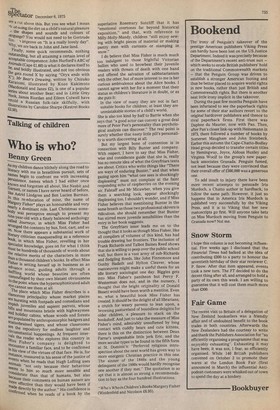Talking of children
Who is who?
Benny Green MY Children dance blithely along the road to iiteracY with me in breathless pursuit, sets of names begin to confront me with increasing Persistence, names which I had either once known and forgotten all about, like Nesbit and G. arnett, or names I have never heard of before, Astrid Lindgren and Ben Lucien Burman. In this re-education of mine, the name of „IViargerY Fisher* plays an honourable and very
arlY a dominant role. Last Christmas some
Was perceptive enough to present my 'Une-year-old with a finely balanced anthology called Journeys, in which Miss Fisher had arranged the contents by bus, foot, cart, and so libl#1. Now there appears a substantial work of arY criticism masquerading as a reference 000k, in which Miss Fisher, revelling in her specialist knowledge, goes on for what I think Must be hundreds of thousands of words about the relative merits of the characters in more an a thousand children's books. In effect Miss ilsher is setting herself up in business as an advance scout, guiding adults through a baffling world whose beauties are often camouflaged by their own blatant obviousness to the point where the hypersophisticated adult eYe cannot see them at all.
, The place which Miss Fisher describes is a clarnorous principality whose market places are bursting with footpads and comedians and irMnish juveniles and sapient parrots, whose
IS and mountains bristle with highwaymen and holiday cabins, whose woods and forests are Populated by anthropomorphic badgers and scatterbrained tigers, and whose classrooms ar_.irc e the repository for endless laughter and ,umstantial happenings. At frequent interals the reader who explores this country in e iss Fisher's company is delighted to . ncounter a familiar face, and to be confirmed !ti his View
of the virtues of that face. He is, for lenstveance, reassured in his sense of the justice of an .nts
When he reads that Hugh Lofting uses mals "not only because their behaviour s_eerns to him so much more sensible and Co to than that of humans, but also necause their comments on human nature are _41Ore effective than they would have been if made directly by the author," His confidence is confirmed when he reads of a book by the
superlative Rosemary Sutcliff that it has "emotional overtones far beyond historical exposition," and that, with reference to Milly-Molly-Mandy, children "still enjoy sewing with bright pieces of material or making pastry men with currants or stamping in snow." I do believe that Miss Fisher is much much too indulgent to those frightful Victorian bullies who used to browbeat their juvenile readers with threats of death with one hand and offered the salvation of sabbatarianism with the other, but of more interest to me is her curious ambivalence about the Alice books. I cannot agree with her for a moment that their status as children's literature is in doubt, or as she puts it: In the view of many they are not in fact suitable books for children; at least they are unmistakable stories of a child's world. She is also too kind by half to Barrie when she says that "a good actor can convey a great deal more of Peter Pan's personality than psychological analysis can discover." The real point is surely whether that nasty little pill's personality is worth discovering at all. But my largest bone of contention is in connection with Billy Bunter and company. With respect, I have to say that Miss Fisher, wise and considerate guide that she is, really has no remote idea of what the Greyfriars texts are about. Critics who write things like "There are ways of enduring Bunter," and that when gazing upon him "what one sees is shockingly displeasing" must not complain at the faint responding echo of raspberries on the evening air. Falstaff and Mr Micawber, when you give them a searching look, appear shockingly displeasing too, I shouldn't wonder, and if Miss Fisher believes that mentioning Bunter in the same breath as those two professional skivers is ridiculous, she should remember that Bunter has stirred more juvenile sensibilities than the entry in her book suggests. The Greyfriars issue leads me on to the thought that it looks as though Miss Fisher, like all compilers of volumes of this kind, has had trouble drawing her frontiers. The inclusion of Frank Richards and Talbot Baines Reed shows that she is willing to peep over the public school wall, but there is a vast army of sub-Richards and fledgling Reeds, like John Finnemore and Gunby Hadath and Hylton Cleaver, whose manoeuvres might make a useful thesis for an idle literary sociologist one day. Biggles gets into Miss Fisher's pantheon but Percy F. Westerman does not, and in the nursery, I thought that the bright originality of Donald Bissett would have been worth a mention. Even so, what a beautiful book Miss Fisher has created. It should be the delight of all librarians, a crutch for weary parents to lean upon, a browsing pastureland of boundless delights for older children, a pleasure to stack on the bookshelf. And just to take the measure of Miss Fisher's mind, admirably unsoftened by long contact with cuddly bears and cute kittens, there is this on the distinction between Dean Farrar's unspeakable little jerk Eric, and the more secular types to be found in the fifth form at St. Dominic's: "Perfervid religious introspection about the next world has given way to more energetic Christian practice in this one. The sinner of the 1840s and the young delinquent of the 1880s would hardly recognise one another if they met." The quotation is so apt that it is almost as strong a recommendation to buy as the four hundred illustrations.
*Who's Who in Children's Books Margery Fisher (VVeidenfeld and Nicolson £6.95).

































 Previous page
Previous page